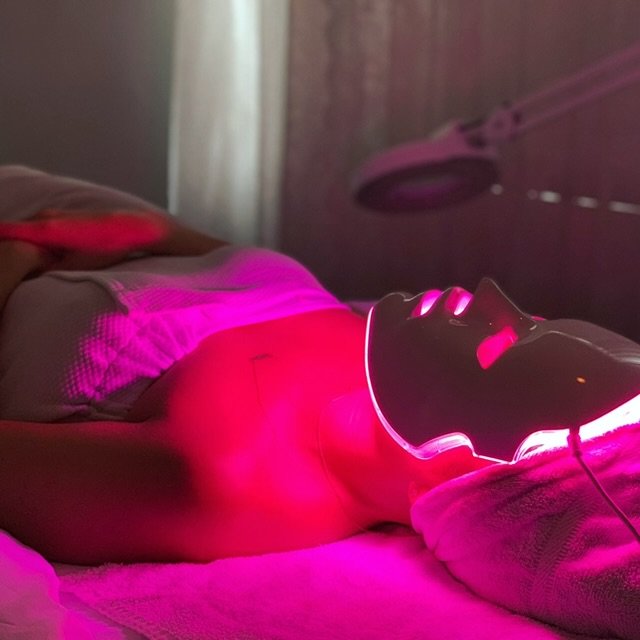Beneath The Surface: Your Guide To Red Light Therapy
“Just as human cells need nutrients from food, light is also a necessary nutrient for cells to function well.” -Ari Whitten
As a holistic aesthetician, I love utilizing effective, non-invasive treatments, and light therapy is one of those treatments. Though the history of light therapy dates back YEARS, red and blue light therapy have become more widely used in the aesthetics industry over the last decade, I’d say. Red light therapy, once known as phototherapy, is a type of LED light therapy that works wonders on the face, and body. It penetrates the skin to reduce inflammation, stimulate collagen production, increase blood and lymphatic flow, as well as increase oxygen in the body. It can even reduce scar tissue! It’s hard to believe this technology can impact our health in such powerful ways. There are promising results that prove this science is not too good to be true! After all, red light was used for NASA in plant growth experiments. (NASA.gov) Later on, it was discovered to be healing for astronauts who experienced pain related issues. How cool is that? Now, let’s touch on a few of those benefits in greater detail.
Reduces Inflammation
Inflammation is your body's response to damage, it plays a pivotal role in the healing and repair process. In other words, your body is telling you to take action, before the issue becomes more serious. Inflammation can be a reaction from many different things such as injury, infection, toxins, lack of sleep, dehydration, or poor nutrition. Regardless of the cause, red light therapy may help. “The light emitted by the red light penetrates roughly five millimeters below the skin’s surface, allowing the mitochondria of cells to absorb it and make more energy” (Dr. Barbara Sturm). A quick science lesson: The mitochondria is the powerhouse of the cell. So, when it is activated by red light technology our bodies go into repair mode, restoring cellular health.
Increases Collagen Production
One of the main attractions to red light therapy is the ability it has to increase collagen production. Increasing collagen can reduce wrinkles and fine lines. Additionally, collagen increases elasticity, making your skin stronger. You’ll notice your skin appearing naturally youthful as you continue treatments. You’ll find that red light, (like any other treatment) you need to be consistent. Don’t worry, I think you’ll find yourself wanting to be consistent.
Reduces Acne
There are different types of light therapy, and each color has different benefits. For example, red light has been known to reduce acne. When inflammation is reduced, it calms down the appearance of acne. Although, some say the most effective acne treatment is blue light, which is most commonly used to target stubborn acne. “The wavelength of the blue light has an antimicrobial effect, making it effective at killing several types of bacteria'' (Healthline, 2019). Lastly, yellow light is a shallow penetration that soothes the skin and boosts lymphatic flow. “Yellow light improves toxins and waste from the skin, which promotes anti-aging” (True light, 2023).
At Home Treatments
There are at home red light treatments you can invest in to keep up with the red light treatments. Although these options are not as high grade as you would experience in a spa setting, they are still a great way to maintain results. Good red light treatments are pricey, but it's important to invest in quality skincare to get quality results. Some brands I love include Platinum , My Skin Buddy, Higher Dose, Celluma, Omnilux, Lightstim, and JOOVV.
Which light will be best for me?
With so many options out there, it's easy to feel overwhelmed by the different information thrown at you. To best navigate LED therapy, focus on your desired result. When purchasing your own device, pay attention to the wavelength. This should be listed on the detail section of the product.“The most beneficial red light wavelength for skin is commonly considered to be 660 nm, which is near the upper range of visible red light. This wavelength has deeper penetration than the shorter 630 nm (nanometer) wavelength, with similar effects” (Platinum Therapy, 2023). There is a great article written on the different wavelengths here. This article provides you with every burning question you might have about nm range. It covers everything you need to know about nm range- because when you invest this much in your skin, every detail matters.
What Is The Difference Between Red Light vs. Near-Infrared?
Now that you’re acquainted with the basics of nm wavelengths, let’s discuss the difference between red light and near-infrared light. Red light, operating within the range of 620-700 nm, effortlessly makes its way through the skin. It reduces inflammation, combates acne, and boosts collagen production. Near-infrared light, on the other hand, reaches deeper levels of the skin at 700-1100 nm, offering therapeutic advantages like alleviating chronic pain, wound healing, and detoxification.
Wrapping Up
In conclusion, incorporating LED therapy into your wellness routine is a safe and effective approach to improving your overall skin health. It is important to be knowledgeable about the different types of lights and their benefits, to target specific areas of your skin. Whether you're struggling with acne, skin texture, or looking for one more thing to add to your wellness routine, LED might be the treatment you’ve been looking for.

